This paper was presented by Dr Ken Henry, Secretary to the Treasury1 as the SirLeslie Melville Lecture on 16 July 2003. The paper explores the tensions surrounding Australia's decision to join the International Monetary Fund (IMF), discusses changes in the world economy since the 1940s and the new tensions that have emerged for the IMF and its various members. The paper reflects upon the future direction of the IMF and the broader international financial architecture, including the role that Australia might play.
Introduction
My lecture today is given in memory of Sir Leslie Melville. Sir Leslie had a long and distinguished career in Australian public policy, economics and education, and his legacy lives on in many of our present institutions.
Sir Leslie held many influential positions during his career but today I wish to focus on one aspect of his career — his role as head of the Australian delegation to the Bretton Woods conference in 1944 and later as Australia's representative at both the IMF and World Bank. Specifically, I would like to use the opportunity of this memorial lecture to reflect upon the system Sir Leslie helped bring about and its relevance to the modern world economy, almost 60 years on from the Bretton Woods conference.
After giving some background on Australia's decision to join the IMF, and the tensions surrounding that decision, I will discuss changes in the world economy since the 1940s and how these have created new challenges for the Fund. I will conclude with some remarks about the future direction of the IMF, the broader international financial architecture, and Australia's role in the development of that architecture.
Origins of the IMF and Australia's decision to join
The IMF was established at the Bretton Woods conference in 1944 to promote international financial stability in the post World War II reconstruction period. The Fund's purpose, as set out in its Articles of Agreement, is to promote international monetary cooperation, financial stability and world economic growth.
At the time the IMF was established the experience of the 1930s was fresh in many minds. Competitive devaluations of the 1920s and 1930s — often described as 'beggar-thy-neighbour' policies — were seen as a key source of instability in the international financial system. A key part of the answer to this problem, as conceived by the architects of the Bretton Woods system, was to create a system of pegged exchange rates.
The Fund's primary function, then, was to support the maintenance of exchange rate parities, including by lending to members facing short-term balance of payments disequilibria. The Fund essentially acted as an international credit union. Members contributed to a pool of reserves from which countries facing balance of payments deficits could borrow to maintain their pegged exchange rates.2
The IMF model followed closely the proposal put forward by the US Treasury official Harry White.3 Britain had supported the more ambitious model proposed by Keynes. Keynes' concept of an international clearing union would have involved the establishment of an international central bank, fulfilling a lender of last resort role through the provision of virtually unlimited liquidity to countries facing short-term imbalances. Harry White's credit union model was less ambitious, particularly in terms of the amount of liquidity it would promise.
Sir Leslie and the Australian team were attracted to the international clearing union model put forward by Keynes.4 But Australia had bigger ambitions for the new Fund. Sir Leslie sought, among other things, agreement to having the Fund charged with the policy objective of full employment.5 The rationale was that buoyant levels of demand in the world economy would assist small, open, economies like Australia to achieve full employment without encountering constraints on the balance of payments.6 Sir Leslie was not successful. Australia was alone in pushing this objective and the Bretton Woods architects considered the inclusion of a full employment objective to impose too much of a constraint on the policies of the major economies.7
Sir Leslie was also concerned with the degree of inflexibility in exchange rate adjustments under the White plan, compared with the Keynes plan.8 In addition, Australia thought the White plan was too limited regarding the size of the Fund, as it meant that Australia's drawing rights would be quite small. Others shared this view.9
Frustrated with the model proposed (and in some quarters, distrustful of the nature of the institution) Australia did not join the IMF when it was established in 1944.
Melville was clearly embarrassed by this decision.10 Twenty nine countries were founding members of the Fund and Australia and Russia were the only major players not to sign up to the Bretton Woods agreement.11
The IMF was a topic of lively debate within the Australian Cabinet in the early years. Dr Evatt, along with other ministers, was vehemently opposed to the IMF.12 There was a view that the Fund would be run by international financiers — the group held responsible for the depression in the 1930s. Evatt and others believed that the IMF would be dominated by the big American banks who would not be at all sympathetic to the social problems facing member countries. Eddie Ward, a member of Chifley's ministry, claimed on national radio in March 1946 that the Bretton Woods agreement threatened the 'sovereignty of Australia' and it would 'enthrone a World Dictatorship of private finance, more complete and terrible than any Hitlerite dream'.13
Prime Minister Chifley, while wary of 'Wall Street capitalists' and their concentration on 'dollar profits', was willing to set aside these reservations and place his trust in the 'brighter and more humanitarian' outlook on world affairs held by the US State Department.14 He pushed his colleagues to ratify the Bretton Woods Agreement.15 Australia eventually became a member of the IMF in 1947.
While debate about the merits of the Bretton Woods system continues to the present day, it appears likely that the system contributed to the relatively benign economic conditions that prevailed in the 1950s and 1960s. Australia benefited indirectly from the Fund's contribution to this environment and prospered. Australia also relied directly on the Fund a number of times during this period, with the largest drawing being that made under a US$175m Stand-By Arrangement in 1961.16
Developments since 1944
The international financial system has seen many changes since the 1940s — most notably, abandonment of the original Bretton Woods system of pegged exchange rates in the early 1970s and the emergence of capital account crises in the 1990s.17
While no consensus exists on the reasons for the breakdown, between 1968 and 1971, of the system of pegged exchange rates, some factors are commonly put forward. Among these are the breaking of the link between the US dollar and the monetary gold stock. The Vietnam War and the growth in world output and liquidity strained the convertibility of the US dollar into gold
. Increasing capital mobility also put strains on the system by facilitating speculation against fixed parities. Finally, price instability in the US meant that the system of fixed exchange rates increasingly ran the risk of providing a transmission mechanism for higher world inflation, in turn placing pressure on parities.
The breakdown of the system of pegged exchange rates was an important turning point for the Fund. It changed the nature of Fund assistance and, perhaps more importantly, the types of countries that drew on its assistance. But more on this later.
An important recent development has been the rapid expansion of private capital flows between countries and the closer integration of global capital markets. While potentially beneficial for the growth of recipient countries, these developments have not always been benign.
The last decade has seen a string of crises in emerging markets — in Mexico in 1995, Asia in 1997 and 1998, Russia in 1998, Brazil in 1998 and 2002, Argentina in 2001-02, and Turkey in 1999 and 2000-01.
It is clear from these crises that the nature of the problem has changed considerably since 1944. First, there is the increasing scale of private capital flows. Large amounts of mobile private capital have increased the risk of sharp market reactions in the face of emerging economic imbalances. The loss of confidence in previously favoured assets, indeed entire countries, can be quite sudden, resulting in dramatic reversals in capital flows with disorderly and damaging economic adjustment.
The new development here is not that private capital flows can be destabilising. This much has been clear since the 'tulipomania' of the 1630s in Holland, and was further graphically illustrated in the extraordinary fluctuations in the share prices of the South Sea Company and its imitators in the early 1700s.18 The novelty of the recent period is in its scale: the fact of private suppliers of capital taking a position on an entire country, or even, as in the Asian financial crisis of 1997-98, a group of countries.
Second, and more recently, crises have been triggered increasingly by, and have exposed, serious structural policy weaknesses, particularly in financial sectors.
While it would be overly simplistic to seek to draw a strict dichotomy between financial crises and 'traditional' balance of payments crises, it is clear that the strains on domestic financial systems posed by the increasing scale of capital flows have introduced a new element into modern crises.19
The changing nature of the underlying problem has led to changes in the role of the IMF. The Fund first established a formal surveillance role in the late 1970s via an amendment to its Articles of Agreement. This role has evolved, from one of examining the macroeconomic stabilisation policies of member countries to examining areas of structural reform, particularly prudential and regulatory policy in the financial sector. There has been an increasing emphasis also on early detection of vulnerabilities, leading to a focus on issues such as the size, maturity and currency composition of external debt. The widened scope of individual country monitoring has been complemented by an emphasis on multilateral and regional surveillance to identify interactions and linkages that might facilitate the spread of crises.
The scope of conditionality — the conditions applied to IMF loans — has likewise increased in complexity.
This changing role of the Fund has not been unquestioned. The recent period has seen considerable debate about the effectiveness of the Fund's policies in terms of crisis prevention and crisis resolution. Treasury has spoken on these issues in other fora.20 The important point to note is that there is increasing tension between those who want the IMF to be more vocal and forthright and those who argue it goes too far already in pushing policy adjustments on its members.
The emergence of these tensions has coincided — though it is far from a coincidence — with a pronounced trend in the direction of Fund assistance. In the early period of the IMF's history, those countries with the greatest influence over IMF policies were also major users of the Fund, consistent with its 'credit union' role. Chart 1 shows that during the 1950s and 1960s the industrialised economies drew heavily on Fund resources. They were the key players under the Bretton Woods system of exchange rate parities. Their use of Fund resources tapered off during the 1970s following the breakdown of the Bretton Woods system. From the 1980s onwards, IMF assistance has been directed almost exclusively towards emerging markets.
Chart 1: Relative use of IMF resources:
industrialised vs developing countries
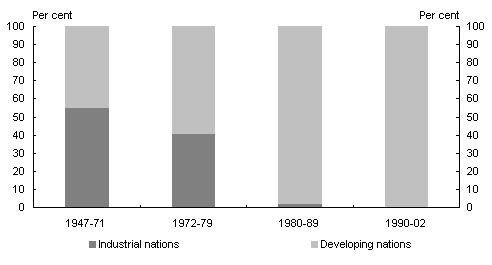
Source: International Monetary Fund, International Financial Statistics online.
Chart 2 looks at the data in a different way, examining the peaks in the use of IMF resources over time (in terms of the share of total lending) of the Fund's largest users in a particular year. The largest peaks in the early years were attributable to the UK (with its largest drawing occurring around the time of the Suez Crisis in 1956). A peak is attributable to Italy in 1975 following fallout from the first oil price shock. However, all of the subsequent peaks are attributable to emerging markets — Mexico in the early to mid 1990s and Turkey and Russia more recently.
The new, emerging markets, group of users of Fund resources has relatively little influence over Fund policies. Indeed, it is arguable that their influence has declined. Somewhat paradoxically, the reason for this is to be found outside of the Fund, in the emergence of other multilateral fora with more concentrated decision making power— including with respect to the power to determine Fund policies.
Chart 2: Largest users of Fund resources
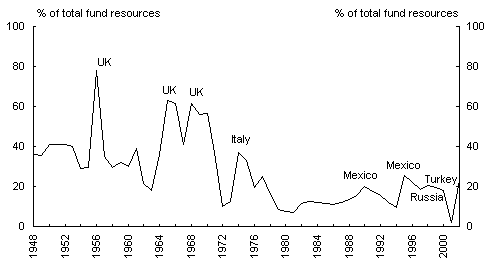
Source: International Monetary Fund, International Statistics online.
In 1973, a short time after the breakdown of the Bretton Woods pegged exchange rate system, the United States Treasury Secretary invited the British, French and German finance ministers to Washington for an informal discussion regarding the international monetary system. Japan joined subsequent discussions.
This group, which came to be known as the 'group of five' or 'G-5', expanded to become the G-7 in 1975 with the participation of Canada and Italy. With the inclusion of the Russian Federation in recent times the group is sometimes referred to as the G-8. While remaining a largely informal policy forum, the G-7 (or G-8) now meets regularly and appears to have supplanted the IMF's policy coordination role for the major economies. It seems increasingly also to see its role as including providing direction and guidance to the IMF and other international institutions.
The diminishing reliance by the major economies on IMF support cannot simply be explained on the basis that these economies no longer need external finance. The fact is that many do. Rather, there would seem to be two explanations. The first is that private financing has replaced official financing in many cases. In fact, many would see the need for Fund resources now being symptomatic of a lack of access to private capital markets. The second reason is that where official external financing has been preferred, sources other than the IMF have been used. A prime example occurred in September 1992 when the pound sterling was suspended from the Europea
n Exchange Rate Mechanism (ERM) following a wave of selling of the pound on foreign exchange markets. The UK had borrowed under the ERM's Very Short Term Financing Facility (VSTF), which became available as the pound reached the bottom limit in the ERM. Other countries, such as Italy and France also used the VSTF. Ironically, these non-IMF funds were accessed to support pegged exchange rates.
Where does this leave the IMF? One plausible view is that the major economies have come to see the Fund as having a role, primarily, in countering, or reducing the risk of, instability in emerging markets. Indeed, we may well ask whether the major economies have not come to see the Fund's principal role to be to make the world a safer place for internationally mobile capital — a role to be played out through the conditionality attached to Fund programs and surveillance. This is a role that sits rather well with the Fund's foundation objectives of financial stability and world growth.
But one might want to question the presumption supporting this view — which is that the primary source of global financial instability is, and will continue to be, in the emerging markets. This perspective might have been understandable when the major economies saw themselves as capital exporters to emerging markets. But it is a particularly odd perspective today.
If the world were to be divided into six economic regions — the United States, Europe, Japan, other advanced economies, the newly industrialising economies and the developing world — the principal regional attractor of international capital would appear to be the first (see Chart 3). The United States is attracting more capital than the whole of the developing world. Moreover, given the size of the United States' current account deficit, this is likely to be the case for many years. As far as the immediate to medium-term prospects for international financial stability are concerned there is at least as much riding on the quality of United States economic policy as there is the macroeconomic and structural policies of the emerging markets.21
Chart 3: Global savings-investment imbalances22
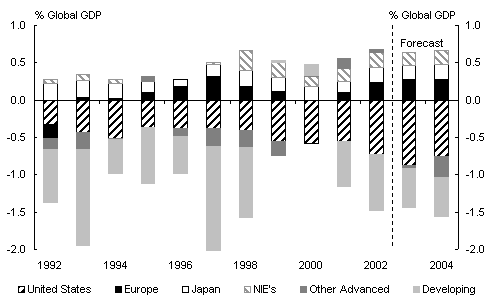
So there is some irony in the fact of the major economies having stopped using the IMF as a source of advice. The reason they have done so is presumably that they have stopped using the Fund as a source of external finance. Why listen to what the bank manager thinks of you if you have no need to apply for a loan? Not surprisingly, the Fund has not brought about necessary corporate and financial restructuring in Japan. Persistent constraints to product and labour market flexibility in Europe remain. And the Fund has done little to convince the United States (or anyone else for that matter) of the risks associated with its singular current account position. These failures could have serious implications for international financial stability.
But there is a further irony. The lack of impact of Fund advice in the major economies undermines its credibility everywhere else and adds to the tension between developed economies and emerging markets. The latter, who see much of the past volatility in capital markets as having originated from the major economies, question why they should follow Fund advice if the major economies will not.
Partly in response to these sorts of tensions, in 1999 the G-7 formed a new forum called the G-20 to involve a broader spectrum of nations in deliberations about international finance and development issues. The G-20 is comprised of the G-8 countries, Australia and the main emerging market economies (Turkey, Saudi Arabia, South Africa, China, Korea, Indonesia, India, Mexico, Argentina and Brazil).
A further trend involves the establishment of specialised institutions that complement the role of the IMF. Included amongst these is the Financial Stability Forum (FSF), established by the G-7 to promote discussion amongst members on appropriate regulatory and prudential practices. The Financial Action Task Force on Money Laundering (FATF) is another forum established by the G-7, created in response to mounting concern over money laundering and the threat it poses to the banking system and to financial institutions. The work of the FSF and FATF complements, and is complemented by, the work of the various international standard setting bodies.
Challenges
Australia has always valued its membership of the multilateral institutions as a means of helping shape the international rules of the game in a way that it cannot do unilaterally. Our membership of the IMF and other international institutions provides an opportunity to help cultivate a benign international environment within which Australia can prosper. It also provides a vehicle to promote the interests of the region in which we reside and on which our future prosperity depends.23
To date, our influence in affecting the shape of international finance has rested on two pillars. First, an ability to 'punch above our weight' in multilateral fora. And second, an ability to use our special bilateral relationships with each of the major players, and especially the United States, to encourage them to provide effective leadership in those multilateral fora. I cannot see the Australian Government diminishing the importance of these pillars of influence. But the case for using the multilateral processes rests not only on these pillars. It rests, more importantly, on the continuing relevance and effectiveness of those multilateral processes.
The future relevance and effectiveness of the IMF (and the other international institutions) is very much a national interest issue for Australia.
The IMF, and the international community more broadly, face many challenges in addressing the economic problems of the modern era. Not least among those challenges are the significant tensions between those countries pushing for IMF advice to be more effective and those questioning Fund legitimacy.
What is missing is a strong sense of ownership of IMF policies by all member governments. Critical to achieving ownership is representation reflective of relative economic weight.
Chart 4 shows regions' shares of IMF member GDP (in Purchasing Power Parity (PPP) terms24) in 1975 and 2001. China is the big news story here, having seen the largest rise in share, from around 3 per cent of the world economy in 1975 to around 11 per cent in 2001. In 1975 China had a smaller economy than Africa, but by 2001 had become the second biggest economy in the world, and by a considerable margin.25 The rest of East Asia, Eastern Europe and Central Asia have also increased their shares of the world economy. There has been a relative decline in the share of the Americas (though the United States remains the dominant economy) and Western Europe.
Chart 4: Share of IMF member GDP (PPP)
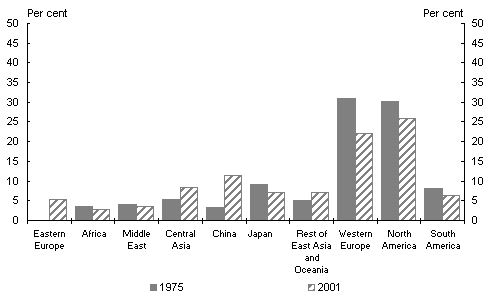
Source: World Development Indicators online.
Chart 5 shows changes in IMF quota shares over the same period. These have moved (very) broadly in line with GDP shares; that is, there has been a shift in representation from North America and Europe to some of the Asian economies. But the trend in quota shares has been much less pronounced than in GDP shares.
Chart 5: Share of IMF quota
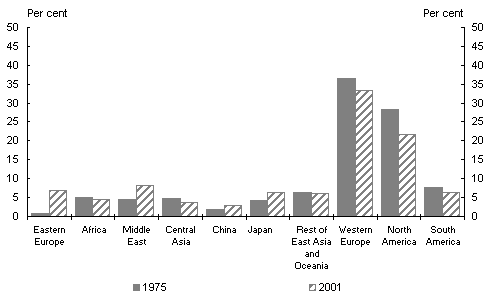
Source: In
ternational Monetary Fund website and Garristen de Vries (1976), p 306-308.
Chart 6: Quota share minus share of IMF member GDP by region
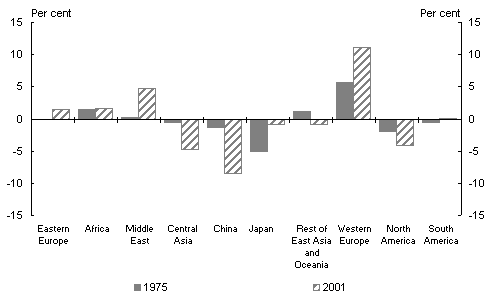
Source: World Development Indicators online, International Monetary Fund website and Garristen de Vries (1976), p 306-308.
Chart 6 brings Charts 4 and 5 together. It measures the differences between quota shares and shares in IMF member GDP — with a negative number implying 'under-representation' and conversely for a positive number. The determination of IMF quotas is a complex issue and Chart 6 admittedly provides an over-simplified picture of whether country quotas are representative or not. I will not explore the intricacies of that debate here. However, Chart 6 reveals a clear trend. The quota shares of China, the rest of East Asia and Central Asia have not kept pace with the rapid growth in these economies. On the other side of the coin, Western Europe is the most over-represented region in comparison to its economic standing, and has become increasingly overweighted since the 1970s.26
These trends have implications for the on-going legitimacy of the Fund. If it continues disproportionately to represent the interests of the Western industrial countries, and not fully recognise the growing economic importance of Asia, its legitimacy, and with that its effectiveness, will decline. The tension will become more pronounced over time. The Korean economy, which was around half the size of the Australian economy in the mid-70s, is now larger and continues to grow at a faster rate. If recent growth trends were to be maintained, the size of the Chinese economy would approach that of the United States in a decade's time.
It should come as no surprise, then, that there has been interest in recent years in the development of regional financial institutions in the Asia-Pacific region. While these may give regional economies a greater sense of ownership of outcomes in international crisis management and fill some of the gaps in the representativeness of the Fund, pressure for their development may reflect a view that the Fund is already losing its relevance in the region.27
Australia has, especially in the past few years, argued the case for reviewing Fund representation arrangements. To correct for the under-representation of Korea at the IMF Executive Board, we have agreed to share with Korea the chair of our constituency at the IMF, with Korea assuming that role next year.
Representation arrangements are important because the backing of national governments is key to ensuring the legitimacy of the Fund. Unless the Fund's membership has collective ownership, the legitimacy of Fund recommendations will always be questioned. But this does not mean that, unless the representation issues can be fixed, the Fund should step back from its role of policy adviser. In fact, this role should be reinforced — consistent with the original credit union focus — rather than allowing the Fund to slide into the role of unconditional provider of liquidity (a passive lender of last resort).
National governments, through their representation on the IMF Board, must support the Fund when it gives robust policy advice and should encourage the Fund to make rigorous assessments of requests for resources. This will mean, on occasion, resisting the temptation to use the Fund's resources to effect large bailouts.
Of course, there will always be political pressures on the Board, whatever its composition, to provide assistance to countries in crisis and there is the risk of these immediate political pressures forcing decisions that undermine the implementation of sound policies in the medium term. This is a difficult tension for the Board to address, but it is important that member countries avoid sacrificing Fund credibility in pursuit of short-term goals.28
Consistent with this philosophy, Australia has pushed hard at the IMF Board to ensure that Fund financing is linked to sound policy advice. As a case in point, Australia was one of five chairs at the IMF Board to abstain from supporting a transitional program for Argentina in January of this year. The larger economies were seeking to push through a program to roll-over Argentina's debts in response to short-term political pressures but offered little in the form of policy solutions to Argentina's severe economic difficulties.
Furthermore, it is important not only that the governance of individual institutions such as the IMF is right, but also that the overall financial architecture is right. It would be naive to believe that the major powers will not continue to dominate the international financial institutions. However, it is possible to introduce checks and balances that will help legitimise their activities. For this reason, Australia has engaged actively in the work of the G-20, which brings together a balance of representation from the G-7 economies, emerging markets and smaller industrial countries like ours.
The G-7 has played a valuable 'guidance' role for the Fund to date. However, the G-7 cannot enhance Fund legitimacy since it represents only the interests of the larger developed economies. Quite possibly, guidance from the G-7 has diminished the Fund's legitimacy as its members have been seen to be pursuing their own agenda through the Fund.29
The G-20, on the other hand, could play an important role here. It represents a reasonable cross-section of the IMF's membership, including both developed and emerging market views and capturing the growing influence of the fast-developing economies. It is potentially a powerful tool for facilitating a dialogue between a representative group of member governments, for achieving agreement among key economies on issues of common interest, and for getting emerging concerns of these key economies onto the IMF's radar. This has been shown by the G-20's work in recent years identifying policy lessons for member countries in the areas of globalisation, economic growth and poverty, much of which has the potential to be directly relevant to the activities of the Fund.30 The G-20 is better placed than the G-7 to contribute to Fund legitimacy.
Conclusion
The current generation faces significant challenges in maintaining the relevance of the institutions passed on to us by Sir Leslie Melville's generation. The economic landscape of the early 21st Century is very different from that of the 1940s. The roles of the international financial institutions are being questioned. Alternative sources of advice and support are being sought.
Yet Australia has an important stake in the future of the IMF. As a small, open, economy, the stability of the broader international financial system will always be important to our national prosperity — a point underscored by the financial turmoil in the region in the late 1990s. And the best means we have for influencing the design of that system is the Fund. This is as true today as it was in Melville's time.
But we are well placed to promote the relevance of the institution Sir Leslie helped to build; to ensure that it is credible, that its legitimacy is enhanced and that it becomes even more effective.
Australia is an industrial economy and net creditor at the Fund, yet sits outside the G-7 'club'. Given our geographical position amongst the emerging markets of Asia, and our recognition of their importance to us, we are more attuned to the needs of these economies than are the major developed countries of the North. And the strength of our bilateral relationships with those major northern playe
rs provides a vehicle for influencing their exercise of responsible leadership in the multilateral institutions.
As in Sir Leslie Melville's time, there is considerable opportunity for us to use our unique position to promote a better international financial architecture.
BIBLIOGRAPHY
Bordo, M. D. (1992), The Bretton Woods International Monetary System: An Historical Overview, Working Paper Series, National Bureau of Economic Research Working Papers Series, Working Paper No. 4033.
Boughton, J. (2000), Northwest of Suez: the 1956 Crisis and the IMF, Working Paper 00/192, International Monetary Fund.
Boughton, J. (2001), The Silent Revolution — The International Monetary Fund 1979-1989, International Monetary Fund.
Boughton, J. (2002), Why White, Not Keynes? Inventing the Post-War International Monetary System, Working Paper 02/52, International Monetary Fund, March 2002.
Commonwealth of Australia, Parliamentary Debates (Hansard), Session 1946-47, First Session of the Eighteenth Parliament (Second Period) (From 19February 1947 to the 6June 1947), 11 GEO. VI, pp 590-593.
Cornish, S. (1993), Sir Leslie Melville: An Interview, The Economic Record, 69(207), December 1993, pp 437-57.
Cornish, S. (1999), Sir Leslie Melville: Keynesian or Pragmatist?, History of Economics Review, Summer 1999, no. 30.
Cornish, S. (2002), Leslie Garfield Melville 1902-2002, The Economic Record, 78(243), December 2002, pp 471-478.
Costello, P. (2002), Australia's Role in Asia, Address to the Australasia Centre of the Asia Society, 16 October 2002.
Council on Foreign Relations (1999), Safeguarding Prosperity in a Global Financial System: The Future International Architecture, Hills, C. and Peterson, P. (co-chairs), Goldstein M. (Project Director), Institute for International Economics, USA.
Curtin, D. and Fisher, S. (2000), Strengthening the International Financial System: Key Issues, World Development, 28(6), pp 1133-1142, Elsevier Science Ltd., Great Britain.
Day, D, (2002), Chifley, Harper Collins Publishers, 2001.
de Brouwer, G. (2002), The IMF and East Asia: A Changing Regional Financial Architecture.
Dyster, B. and Meredith, D. (1990), Australia in the International Economy in the Twentieth Century, Department of Economic History, University of New South Wales, Cambridge University Press, Melbourne.
Eichengreen, B. (1999), Toward a New International Financial Architecture: A Practical Post Asia Agenda, Institute for International Economics, Washington, D.C.
Feldstein, M. (1998), Refocusing the IMF, Foreign Affairs 77(2), March/April, pp2033.
Fischer, S. (1999), On the Need for an International Lender of Last Resort', revised version of a paper delivered at the joint luncheon of the American Economic Association and the American Finance Association, New York, 3 January, IMF.
Galbraith, J. K. (1990), A Short History of Financial Euphoria — Financial Genius is Before the Fall, The Larger Agenda Series, Whittle Direct Books, Knoxville Tennessee, 1990.
Garritson de Vries, M. (1976), The International Monetary Fund 1966 — 1971, The System Under Stress Volume I: Narrative, International Monetary Fund, Washington.
Germain, R. (2003), Global Financial Governance and the Problem of Accountability: the Role of the Public Sphere, paper delivered to the annual conference of the International Studies Association, Portland, Oregon, 25 February — 1 March, 2003.
Groenewegen, P. and McFarlane B. (1990), A History of Australian Economic Thought, Routledge, London.
Henry, K. (2002), Spreading the Benefits of Globalisation: 'Selling' the Compounding Benefits of Reform, Address to the G-20 Workshop on Globalisation, Living Standards and Inequality held in Sydney in 2002.
Horsefield, J. K. (1969), The International Monetary Fund 1945-1965: Twenty Years of International Monetary Cooperation, Volume 1, International Monetary Fund, Washington, D.C.
International Monetary Fund, International Financial Statistics, various editions
International Monetary Fund (2002), Annual Report.
Kenen, P. (1994), Managing the World Economy: Fifty Years After Bretton Woods, Institute for International Economics, Washington, D.C., September 1994.
Kenen, P. (2001), The International Financial Architecture: What's New? What's Missing?, Institute for International Economics, Washington, D.C., November 2001.
Meltzer, A. (chair) International Financial Institution Advisory Commission, March 2000, report, www.house.gov/jec/imf/meltzer.htm.
Moggridge, D. (1980), The Collected Writings of John Maynard Keynes, VolumesXXV, XXVI, The Royal Economic Society.
Parkinson, M., Garton, P. and Dickson, I. (2002), Regional Financial Arrangements: What Role in the International Financial Architecture?, Paper presented at the Conference on Regional Financial Arrangements in East Asia, Beijing University, 24-25 March 2002.
Parkinson, M. and McKissack, A. (2003), The IMF and the Challenge of Relevance in the International Financial Architecture, Paper presented to the International Monetary Convention, Madrid, May 2003.
Stiglitz. J. (2002), Globalisation and its Discontents, Penguin, Allen Lane.
World Development Indicators: <http://publications.worldbank.org/WDI/>.
1 This paper has been prepared with the considerable assistance of a number of people in the Treasury, most notably Adam McKissack, Martin Parkinson, Alice Peterson and KarenTaylor. If the paper is to be cited, these names should appear as co-authors.
2 See Boughton (2000).
3 Boughton (2002).
4 Cornish (1999), p 139.
5 Cornish (2002), p 473.
6 Cornish (2002).
7 Moggridge (1980), p 251 and Dyster and Meredith (1993), 185.
8 Cornish (1993), p 449.
9 Horsefield (1969), p 98.
10 Cornish (2002), p 474.
11 El Salvador, Nicaragua, Panama, Denmark (which did not have a government at the time of signing), Haiti, Liberia, New Zealand and Venezuela were the other countries not to sign. Source: Horsefield (1969).
12 Cornish (1993), p 449 and Day (2001), p 445.
13 Day (2001), p 444.
14 Day (2001), p 444.
15 Cornish (1993), p 449.
16 Australia’s largest ever drawing on the Fund was an SDR 332.5m loan in 1977 to meet the terms of the International Sugar Agreement. The loan was made under the IMF’s former Buffer Stock Financing Facility — a facility designed to assist commodity exporters in stabilising commodity prices through the purchase of buffer stocks.
17 This section draws heavily on the material in Parkinson and McKissack (2003).
18 For a particularly readable account of these and other privately initiated bubbles, see Galbraith (1990).
19 See Parkinson, Garton and Dickson (
2002).
20 See Parkinson and McKissack (2003).
21 This is not to argue that the latter are not important. Indeed, they are fundamentally important to economic development in those markets.
22 I am indebted to Steve Morling and other colleagues in the Treasury for this chart.
23 See Costello (2002) for further discussion of Australia’s role in the region.
24 Purchasing Power Parity (PPP) corrects for differences in relative prices. PPP tends to be more stable than exchange rates, which are more sensitive to capital movements and currency speculation. However, PPP uses international market prices, which tend to produce higher GDP figures for large, relatively closed, developing countries.
25 Perhaps as a sign of the rapid rate of progress in China, most commentators continue to believe that Japan holds that position.
26 Like China, North America has become increasingly underweighted. But the reasons are very different. China’s share of world GDP has increased appreciably while its share of IMF quota has barely moved. In contrast, North America’s share of world GDP has fallen appreciably but its share of IMF quota has fallen by even more.
27 See Parkinson, Garton, Dickson (2002) for further discussion of this issue.
28 This issue is discussed further in Parkinson and McKissack (2003).
29 Meltzer (2000).
30 See Henry (2002).